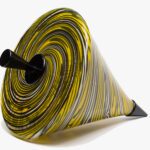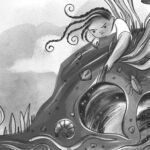Cast & capture
February 5, 2020
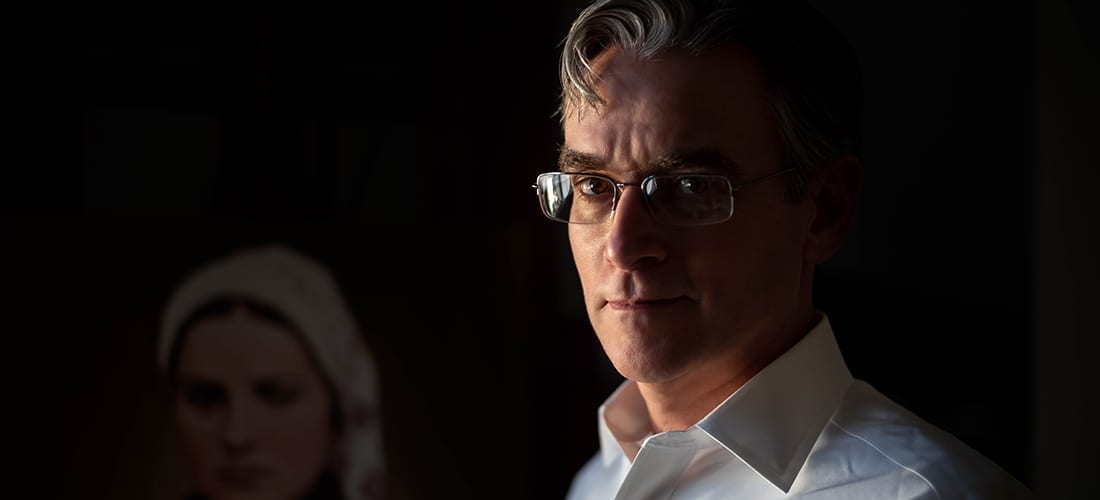
From Neil Armstrong to Rosa Parks to Mother Teresa, Charlotte artist Chas Fagan depicts heroes and public figures near and far.
by Jim Moriarty
Chas Fagan, sculptor and painter, sits on a stool in the middle of his studio, a bonus room upstairs in a comfortable house in a comfortable part of town where the Charlotte skyline peeks through a wintry canopy of trees. As flamboyant as a button-down shirt, his voice is soft, peaceful — more Mr. Rogers than Salvador Dali — and too serene, one might suppose, to have cast some of the world’s most powerful leaders in bronze.
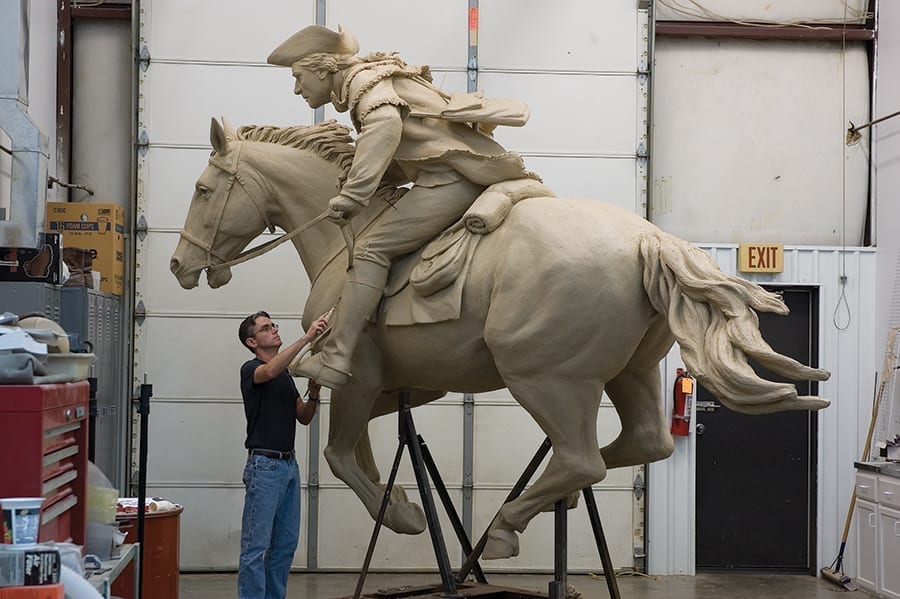

Both top photographs by Charles Johnson, Jeff Groves, provided by U.S. Embassy
Ronald Reagan. Lyndon B. Johnson. George H.W. Bush and his son — 41 and 43, in the presidential parlance. Former U.S. Treasury Secretary and White House Chief of Staff James Baker. Fagan’s series of 9-by-12-inch portraits of all the U.S. presidents created for C-SPAN is on perpetual tour, with stops including the Abraham Lincoln Presidential Library and Museum in Springfield, Ill.
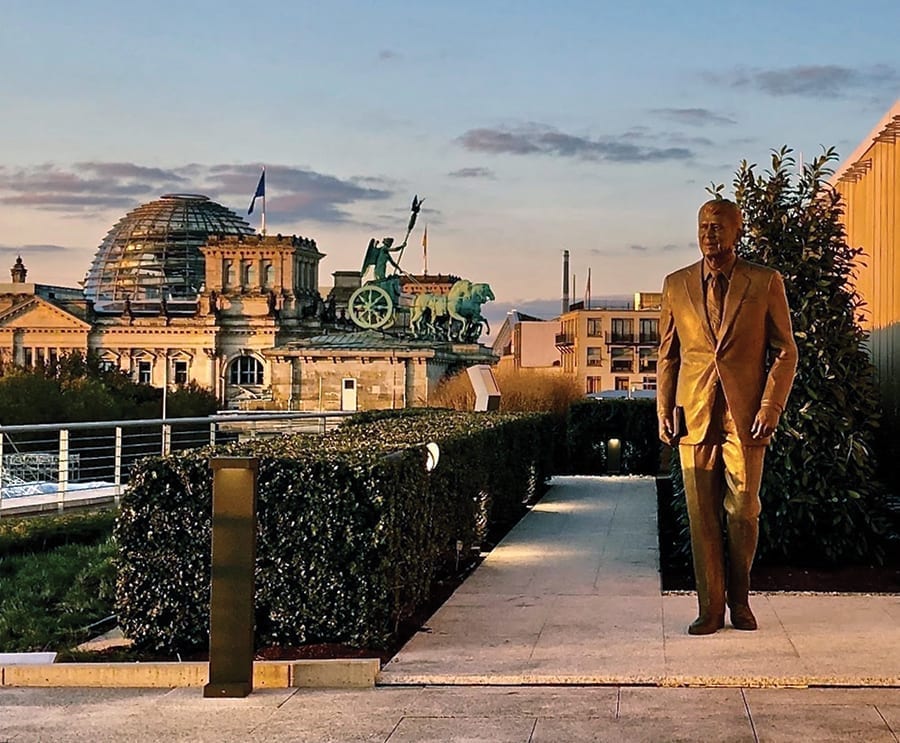
Fagan painted the portrait of Mother Teresa that hung as the backdrop for her canonization, and the portrait of Barbara Bush that hangs in the White House. His busts of Mother Teresa and Rosa Parks decorate the Human Rights Porch in the Washington National Cathedral. He’s in the process of adding Holocaust survivor and author Elie Wiesel. His work welcomes visitors to the Armstrong Air & Space Museum in Wapakoneta, Ohio, sits in the U.S. Capitol rotunda, and stands on the terrace of the U.S. Embassy in Berlin.
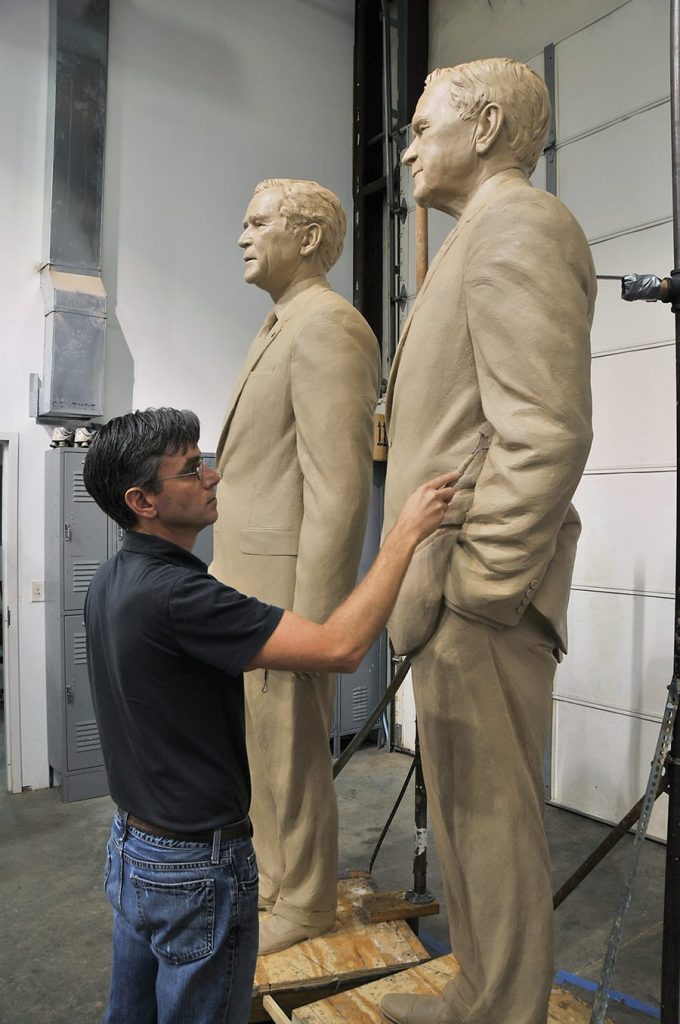
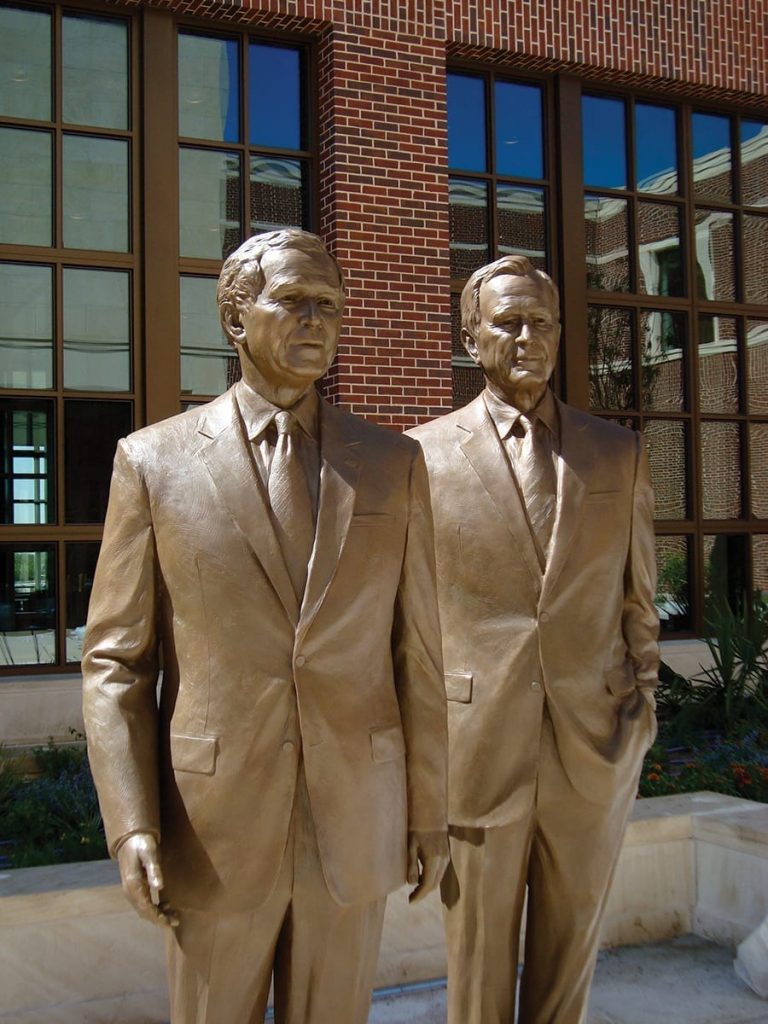
Last year, Fagan crashed a sculpture of Reagan in time to celebrate the 30th anniversary of the fall of the Berlin Wall. The statue was unveiled by Secretary of State Mike Pompeo on Nov. 8. Commissioned virtually at the last minute by the Ronald Reagan Presidential Foundation & Institute, the 7-foot bronze found a home behind the embassy when the Germans, to the chagrin of some conservative U.S. pundits, were disinclined to put it in any of the city’s public squares.
“Germany owes its freedom and prosperity to America and specifically to Ronald Reagan. The least they could do is say thank you, and put up a simple statue,” wrote Marc A. Thiessen in The Washington Post.
But art isn’t politics.
“It’s a historic setting,” says Fagan of the embassy terrace. “The perspective from the site is high up and next to the Brandenburg Gate. You can see the famous sculpture of the chariot and the four horses, the Quadriga, right there, as if you can touch it. It’s amazing.”
The Reagan Library supplied Fagan with a facsimile set of the note cards the president used in his celebrated June 1987 speech, and they would serve a dual purpose in the sculpture. “The figure of the president is walking toward you with a kind of purpose, as if he’s just given his speech, and he’s carrying a stack of his speech cards,” Fagan says. “The very top card has the famous words ‘Mr. Gorbachev, tear down this wall.’ The cool part is, the back of the stack of cards is fanned out a little bit so there’s a hollow, and in that hollow space I slipped in a slice of the Berlin wall. What I love is that element of discovery.”
If some Americans harbored grander hopes for the location of Reagan’s sculpture in Berlin, it couldn’t have been a more appropriate setting for the artist. The son of a diplomat, the Pennsylvania native spent part of his childhood in Brussels and graduated from Yale University in 1988 with a degree focusing on Soviet studies. While he honed his artistic skills as a college student drawing political cartoons for the New Haven Register, after graduation he spent a summer at Leningrad State University (now Saint Petersburg State University) still intent on an academic career.
“When it was over, I was done,” says Fagan, who had come to the realization that he was more in the Garry Trudeau tradition (another Yale cartoonist best known as the creator of the Doonesbury comic strip) than on the Soviet studies track.

His first big break came as a result of a portrait of Reagan he tossed off for The Weekly Standard. “Typical magazine stuff,” he says. “You did it overnight. I forgot about it.” But Ed Meese, Reagan’s Attorney General, didn’t. Meese led a group that commissioned another portrait of the 40th president, and the link was made. Fagan followed that with paintings of Barbara Bush for The Union League Club in New York and then the White House. While he was in Maine doing Mrs. Bush’s portrait, he was simultaneously competing for a commission to sculpt her husband. The National Cathedral had recommended him after the Houston group commissioning the piece was informed that Frederick Hart (the artist who sculpted The Three Soldiers at the Vietnam Memorial) had passed away. Fagan succeeded in getting George Sr. to stand still for a quick set of 360-degree snapshots in the driveway of the Bushes’ Kennebunkport home.
“It was totally fortuitous,” says Fagan, who was ultimately awarded the commission for the statue. “It turned out that the president did not want to participate at all in the creation of his own monument. It was kind of against his character. I didn’t have close-up pictures. I just had the snapshots.” Apparently it was good enough, since he’s done the father and son together, too.
When George W. was sitting for that piece at home in Texas, the Bushes asked Fagan if he’d like to stay for dinner. “He took me upstairs before dinner,” Fagan says. “There was an extra room — a bonus room, and the bonus room was his studio. I had no idea. The fact that he was painting or even interested was not known at all. He had three easels going, in typical fashion. They were actually pretty good, and he was just learning. They were gifts for people. All kinds of stuff. One was a pet portrait. It was a cat, and the cat was on a pillow but he couldn’t get the pillow to look like it was sunken because the cat was on it, so he was asking about shadows and things. We had a good time. We just played.”
Fagan and his wife, Katie, landed in Charlotte in 2002 after Katie’s father retired here. Proximity to Carolina Bronze Sculpture, a foundry in Seagrove about an hour and a half northwest of the Queen City, was another draw. Locally, Fagan’s work is on display at the corner of 4th Street and Kings Drive. The Spirit of Mecklenburg captures Captain James Jack, who in 1775 traveled on horseback from Charlotte to Philadelphia carrying the ill-fated Mecklenburg Declaration of Independence.
Later this year, Fagan will unveil his sculpture of Lyndon B. Johnson, the most recent addition to his pieces in Sesquicentennial Park on the banks of Buffalo Bayou in Houston, where it will join both the Bush and Baker sculptures. Another project taking up Fagan’s time is a monument to the passengers on Flight 93, the United Airlines plane that crashed in a field in Somerset County, Penn., on 9/11 when the passengers attempted to wrest control away from hijackers associated with al-Qaeda. Though Fagan isn’t at liberty to reveal the composition or who commissioned it, artistically it plays into one of his common themes — the moment before.
“The goal for me was to show the human emotion of those heroes, not focusing on the individuals but trying to show the total group,” Fagan says. “They voted to do this. Everyone was in on it. So, it’s an effort to show the emotion of the decision, the moments before ‘Let’s roll.’” Imagine Rodin’s Burghers of Calais as an exemplar. “If I’m asked to depict action, I always like the moment before. As the historian, you know the story. You know what’s going to happen; you’re kind of in their shoes, too.”
Fagan looks for that moment in his portraits as well. “A portrait is a chance to meet someone. As the viewer walks up to this person on the wall, you get to engage with them,” he says. “The moment I want to capture is when they’re just about to say that funny thing. The eyes sparkle, little turn of the lip, something. Whatever it is. It’s like a pre-launch moment.”
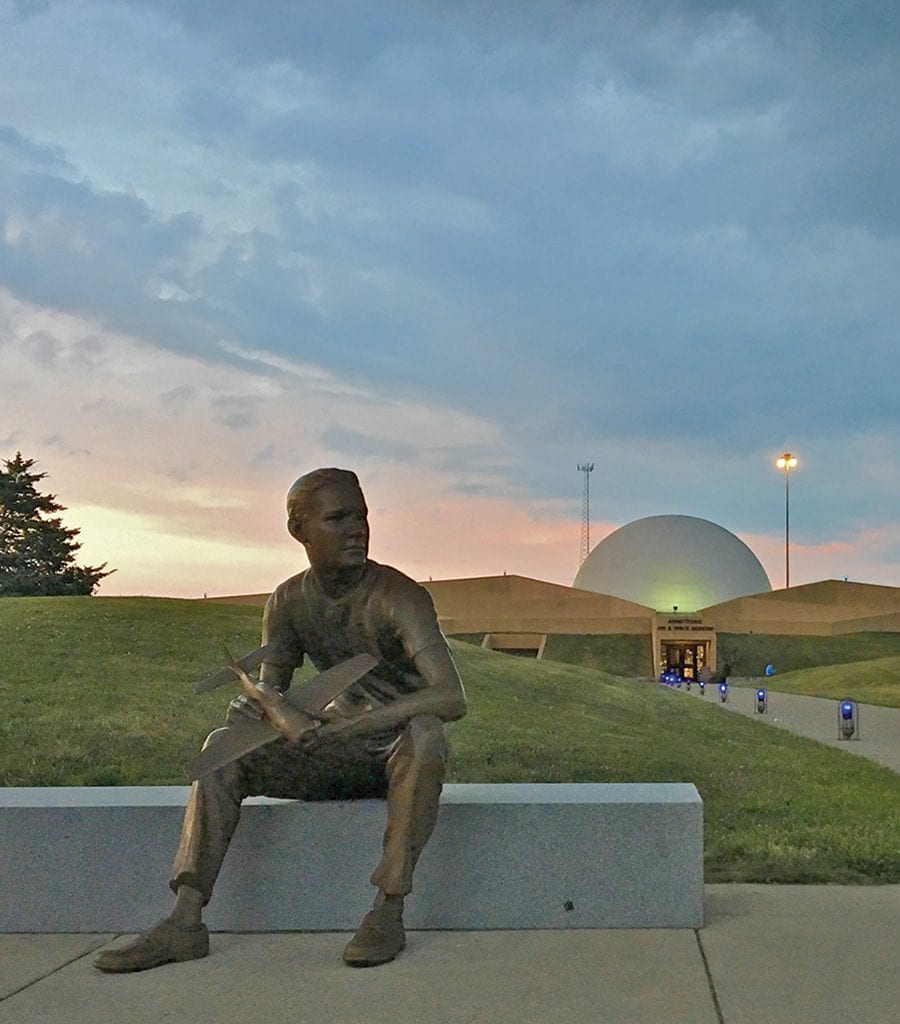

In Ohio, the entrance to the Armstrong Air & Space Museum is designed like a runway. You’re greeted by Fagan’s sculpture of Neil Armstrong as a 15-year-old boy, the kid who threw model planes out of his home’s second-floor window. “I got to go to that window,” Fagan says. At the entrance to the building, a second sculpture of Armstrong shows him just before he gets on the lunar landing test vehicle. “He’s standing all ready, his shoulders back, he’s putting on these big, rubber gloves. He’s ready to go,” Fagan says.
Joan of Arc is pushed off to the side in Fagan’s studio, as is King Simeon of Bulgaria. He’s worked from the life masks of James Madison and Abraham Lincoln. His bust of Lincoln graces the reading room of Manhattan’s Union League Club, and he’s lectured a gathering of historians about that very famous face while standing in the studio of Daniel Chester French, the man who created the sculpture of the 16th president in the Lincoln Memorial.
All in all, it’s a pretty good gig for a quiet cartoonist who talks softly and carries a big talent. SP
Header photo by Zan Maddox

